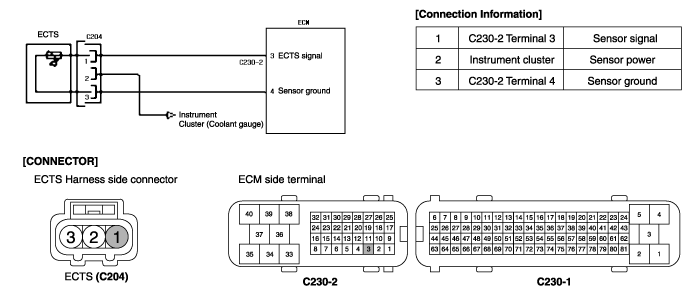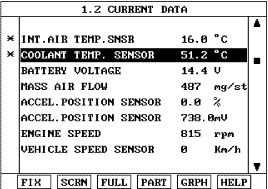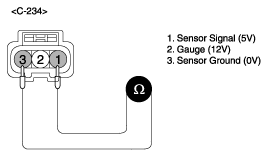Has a problem been found?

Repair as necessary and go to "Verification Vehicle Repair" procedure.

Go to "Signal Circuit Inspection" procedure.

ECTS (Engine Coolant Temperature Sensor) located in the engine coolant passage of the cylinder head.
It detects the water temperature and relays signals to the ECM.
It employs a thermistor, which is sensitive to the changes in the coolant temperature.
The electric resistance of a thermistor decreases as the fuel temperature increases, and increases as the fuel temperature decreases.
The power source in the ECM is supplied to the ECTS via a resistor in the ECM.
The electric resistance of a thermistor decreases in response to the temperature rise.
The ECM judges engine coolant temperature by sensor output voltage and provides optipum fuel enrichment when the engine is cold and in order to operate the radiator fan and the A/C condensor fan.
If the signal exceeds threshold value, the ECM judged this as a fault and DTC is set.
Item | Detecting Condition | Possible Cause |
DTC Strategy | ● Signal check, low | ● Short to ground in signal circuit ● Faulty ECTS ● Faulty ECM |
Enable Conditions | ● Ignition on | |
Threshold Value | ● Output signal < 225 mV | |
Diagnostic Time | ● 0.5 sec. | |
MIL Fuel Limit Fuel Cut EGR Off | ● No ● No ● No ● Yes | |
Fail safe | ● Engine temp. is fixed value of 80°C after cranking and -25°C when cranking by ECM. ● Engine performance is reduced over 120°C ● Radiator cooling fan and A/C condensor fan is operated. ● Air conditioning system deactivation ● Water heater deactivation |
ECTS | ||
Temperature (°C) | 20 | 80 |
Resistance (kΩ) | 2.31 ~ 2.59 | 0.31 ∼ 0.33 |


Ignition "OFF" & Engine "OFF".
Install Scantool and Engine "ON".
Monitor Engine Coolant Temperature Sensor on Current data.

Fig 1) Signal decreases with increasing sensor temperature and increases with decreasing sensor temperature
Is Current data displayed correctly ?

▶ Fault is intermittent caused by poor contact in the sensor’s and/or ECM’s connector or was repaired and ECM memory was not cleared. Thoroughly check connectors for looseness, poor connection, bending, corrosion, contamination, deterioration, or damage. Repair or replace as necessary and go to "Verification vehicle Repair" procedure.

▶ Go to "W/Harness Inspection" procedure.
Many malfunctions in the electrical system are caused by poor harness and terminals.
Faults can also be caused by interference from other electrical systems, and mechanical or chemical damage.
Thoroughly check connectors for looseness, poor connection, bending, corrosion, contamination, deterioration, or damage.
Has a problem been found?

Repair as necessary and go to "Verification Vehicle Repair" procedure.

Go to "Signal Circuit Inspection" procedure.
Ignition "OFF".
Disconnect ECT sensor connector.
Ignition "ON" & Engine "OFF".
Measure voltage between terminal 1 of the sensor harness connector and chassis ground.
Specification : Approx. 5V

Is the measured voltage within specifications?

▶ Go to "Component Inspection" procedure.

▶ Check for short to ground in signal harness.
Repair as necessary and go to "Verification of Vehicle Repair" procedure.
Check MAF
Ignition "OFF"
Disconnect ECTS connector.
Monitor resistance between terminal 1 and 3 of ECTS connector(Component Side).
Temperature (°C) | -20 | 0 | 20 | 40 | 80 |
Resistance (KΩ) | 15.48 ± 1.35 | 5.79 | 2.45 ± 0.1 | 1.148 | 0.3222 |

Is the measured resistance within specifications?

▶ Go to "Check thermostat " as below.

▶ Substitute with a known-good ECTS and check for proper operation.
If the problem is corrected, replace ECTS and then go to "Verification of Vehicle Repair" procedure.
Check Thermostat
Engine "ON"
This test should be performed under cold temperature.
Remove radiator cap.
Warm up the engine to normal operating temperature.
Check that engine coolant circulates.
Does engine coolant circulate ?

▶ Substitute with a known-good ECM and check for proper operation.
If the problem is corrected, replace ECM and then go to "Verification of Vehicle Repair" procedure.

▶ Substitute with a known-good Thermostat and check for proper operation.
If the problem is corrected, replace thermostat and then go to "Verification of Vehicle Repair" procedure.
After a repair, it is essential to verify that the fault has been corrected.
Connect scan tool and select "Diagnostic Trouble Codes(DTCs)" mode and then clear DTC.
Operate the vehicle within DTC Enable conditions in General information.
Are any DTCs present ?

Go to the applicable troubleshooting procedure.

System is performing to specification at this time.